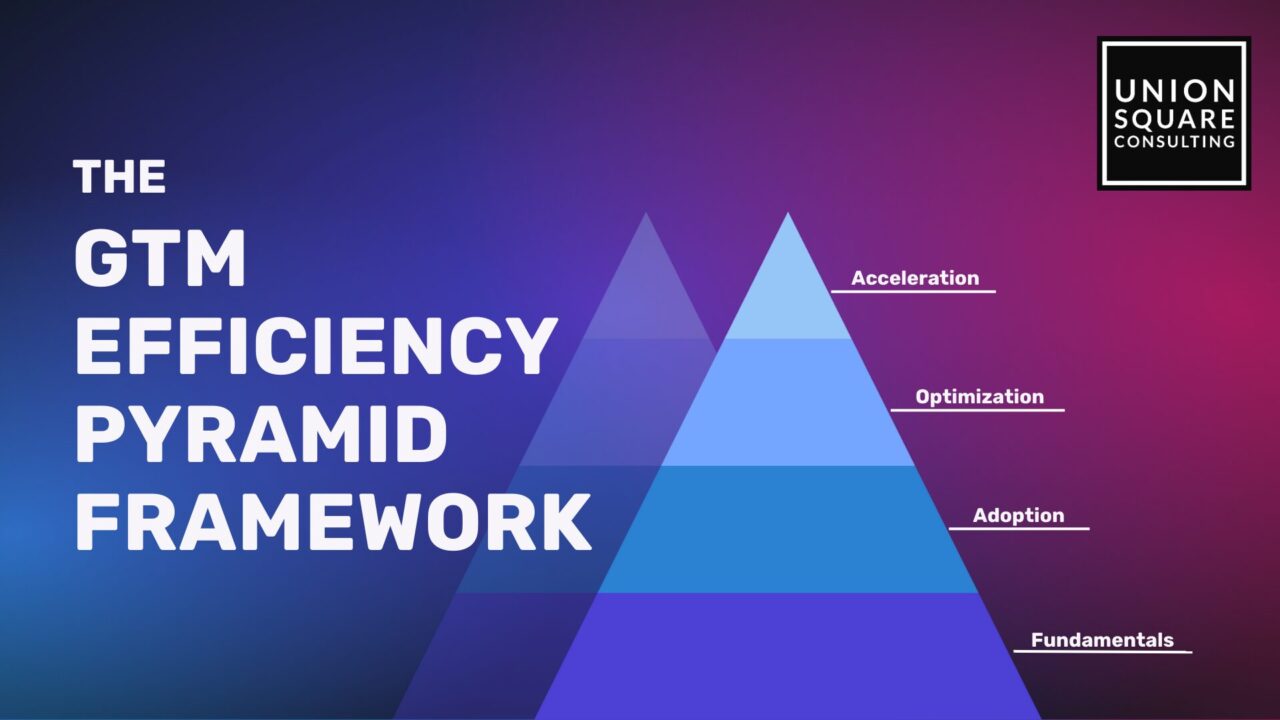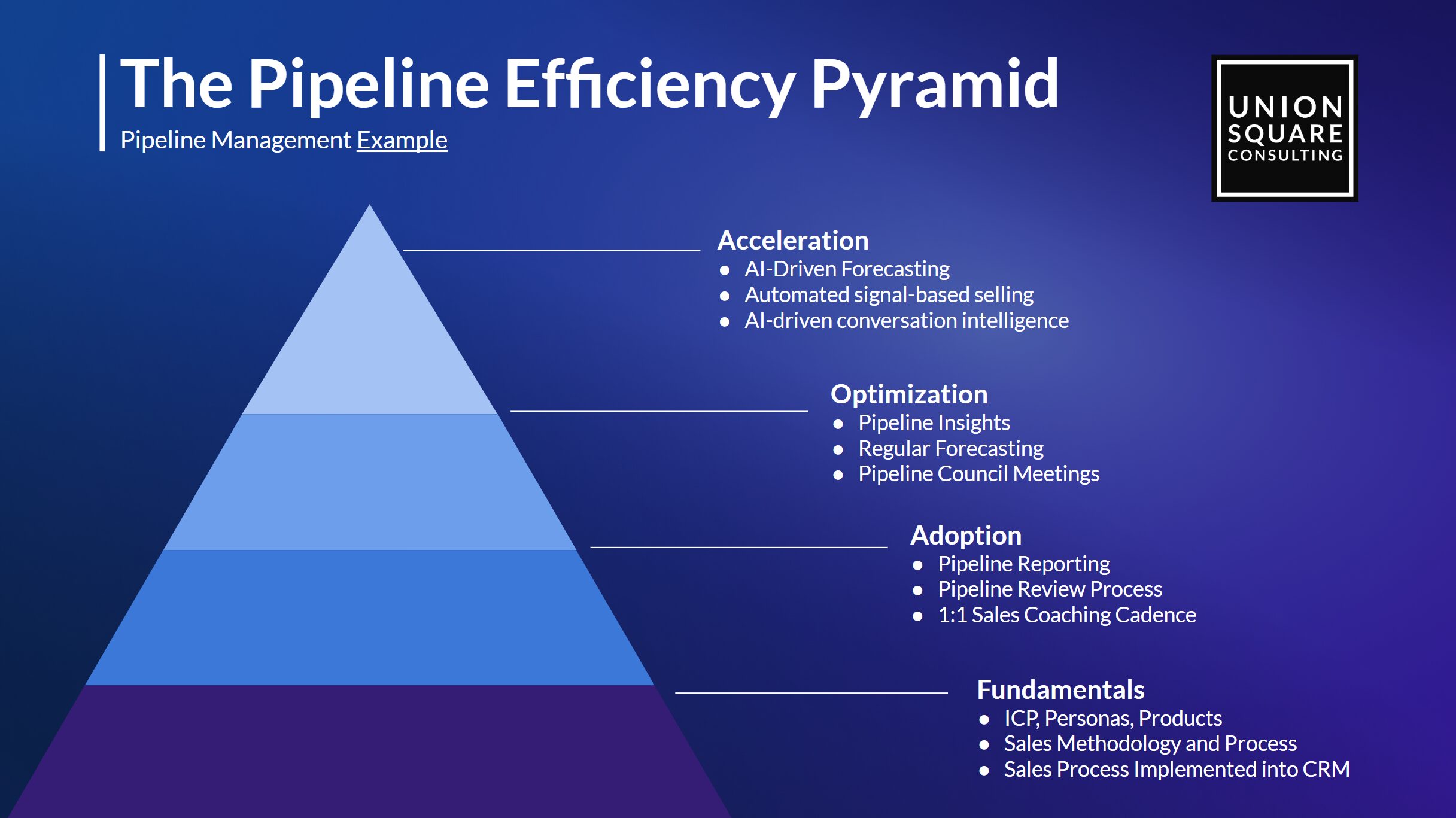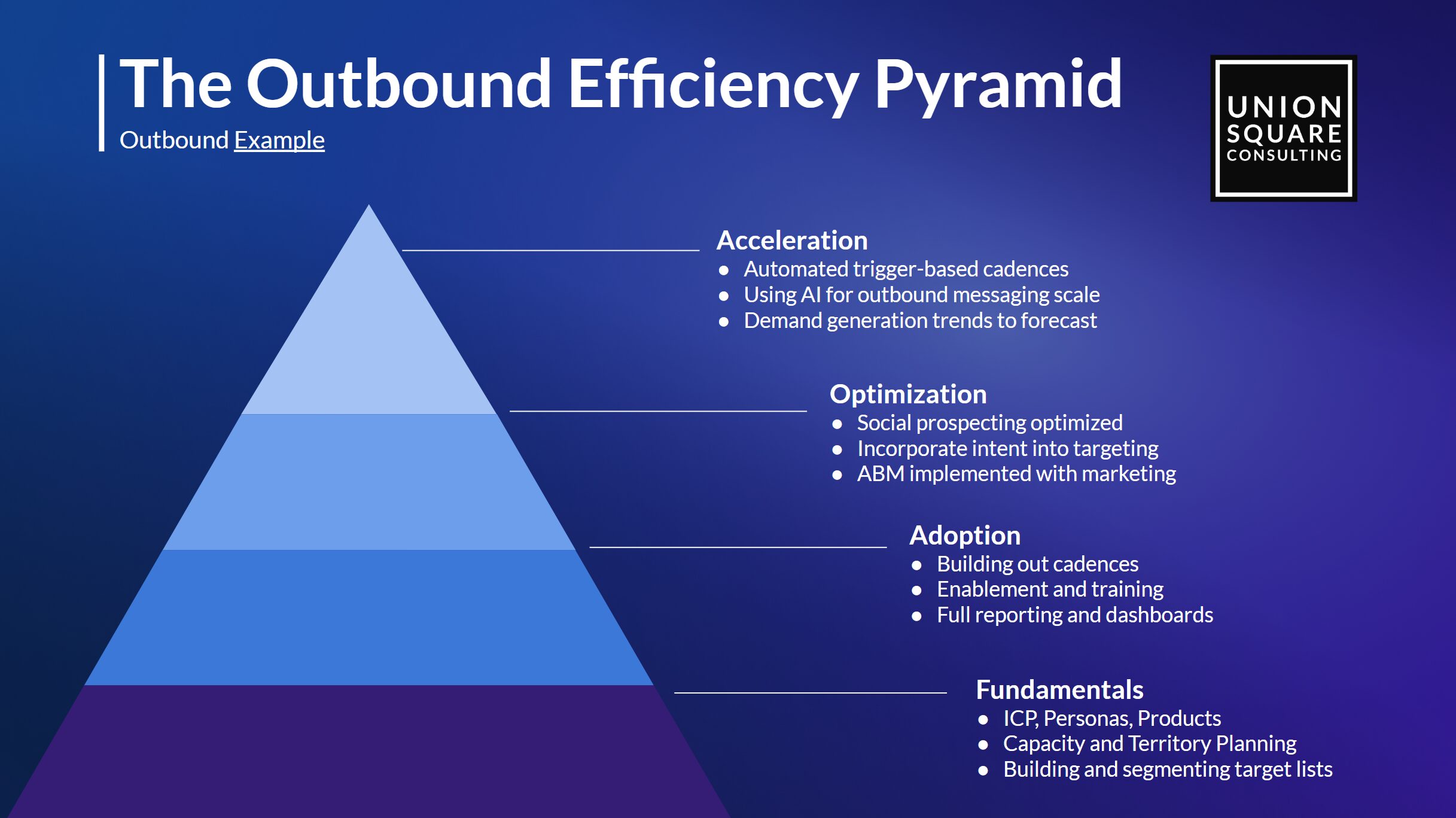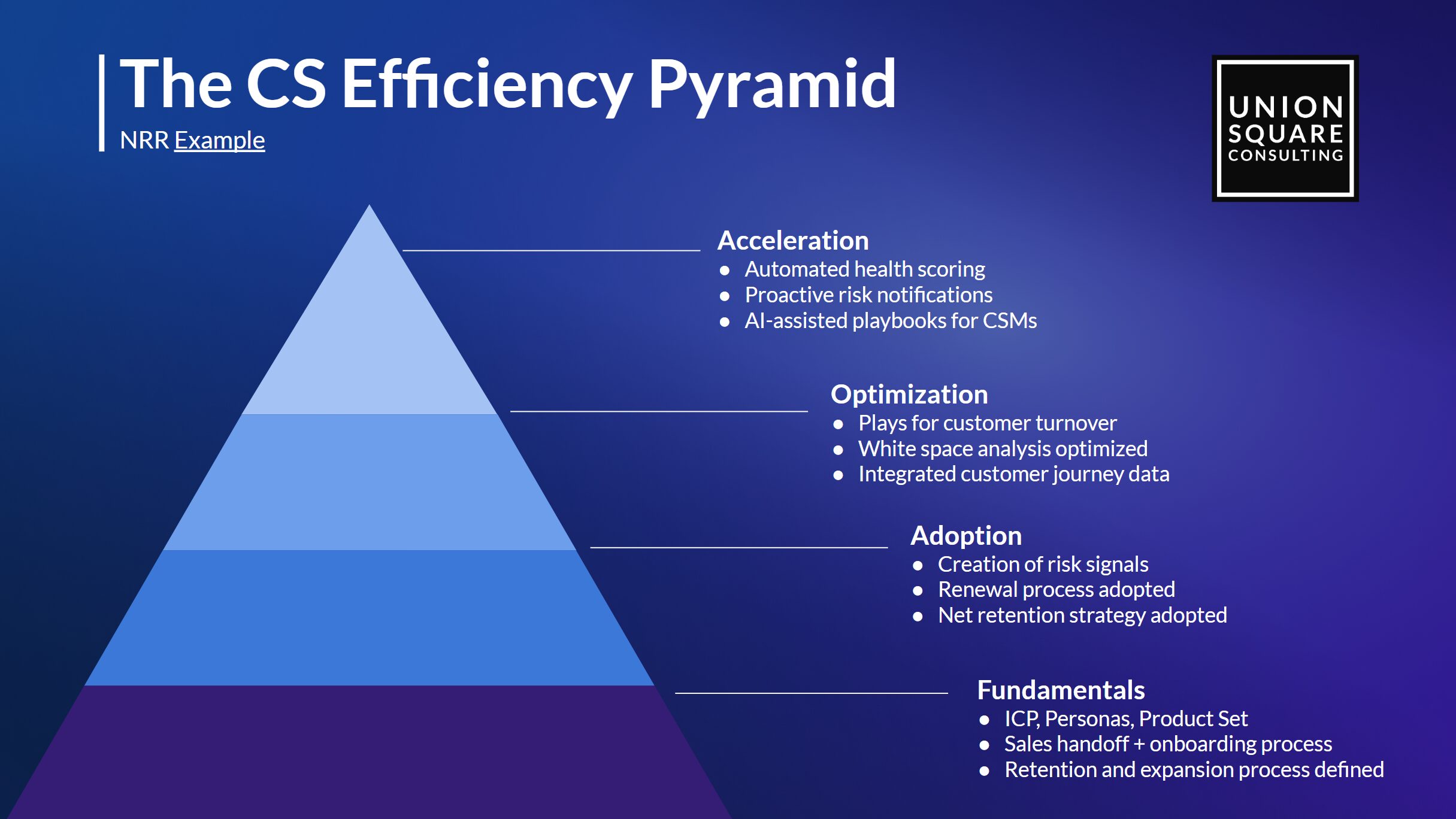
The GTM Efficiency Pyramid Framework
Read time: 12 minutesDownload Infographic: Click here to download high-res PDF
Every CRO and revenue team we meet has 100 things that could be worked on in their GTM. They tell us they don’t have visibility into their business, their outbound and/or inbound motion is struggling, they’re losing deals in their pipeline they shouldn’t, and/or they’re losing customers and expansion opportunities.
It’s a lot – and it’s overwhelming! It’s far too much for one person to wrap their head around. So, after years and years of frustration, we developed a Framework to address this: The GTM Efficiency Pyramid.
In this Framework we break down GTM into four stages of maturity:
Fundamentals: The basics our team needs to simply do their jobs effectively
Adoption: Getting the team to actually execute the right processes to win
Optimization: Measuring and optimizing the GTM process our team is executing
Acceleration: Amplify what’s working with automation, AI and advanced operations

Next, we look at these four stages of maturity across each GTM motion:
Pipeline Management: Is our sales team chasing the right deals, closing them, and forecasting accurately?
Outbound Process: Do we have an effective process to call the right people and convert them to pipeline?
Inbound Process: Do we have an effective process to qualify the right leads and convert them to pipeline?
CS Process: Do we have an effective process to onboard, retain, and expand our customers?
We’ll dive into each of these now.
******************************************************************
Pipeline Management Process
There’s no bigger waste in GTM than filling the top of the funnel with leads and opportunities just to lose them in a broken sales cycle. If landing new customers or expanding existing customers is the top priority, we first need to ensure the Pipeline Management Process is working.

Fundamentals
What basics do sales reps need in place to work their pipeline effectively?
They need to sell to the right people (ICP/Buyer Personas by Product) and they need a Sales Methodology and Sales Process to qualify and close deals. Without this, by definition, they’re chasing deals they can’t win and losing deals they should win. Once we have a process well defined, we need to implement it into the CRM and train our sales reps on the process.
Additionally, without clear qualification criteria, we can’t even measure our pipeline generation efforts in Inbound and Outbound accurately so we don’t know if they’re working well or not.
Adoption
Next, we need to drive the team to adopt the process. We need proper reporting and regular pipeline reviews to continually coach reps on the sales process and reinforce training. This doesn’t happen on its own.
Optimization
Once we’re collecting accurate data, we can start to analyze and optimize the sales process. What’s working? What’s not working? Where can we improve? This is also a prerequisite to accurate forecasting. Additionally, for larger GTM Teams, discussing these issues in regular Pipeline Council Meetings can have a big impact.
Acceleration
As we optimize the basic process we can start looking at ways to amplify it with automation, AI, etc. This is often where people are tempted to start – with the shiny new tools and practices we see at conferences. Unfortunately, none of them work without the foundation in place. You can’t accelerate broken processes or feed AI bad data and expect good results.
- Framework – The Pipeline Management Framework
- Newsletter #71 – Data Driven Sales Coaching
- Newsletter #66 – Implementing Sales Process into the CRM
- Newsletter #62 – How to Conduct Pipeline Reviews Like Salesforce
- Newsletter #56 – Create Strategic Alignment with a Pipeline Council
- Newsletter #32 – Why Do So Many SaaS Companies Fail to Scale
- Podcast – Create Strategic Alignment with a Pipeline Council
- More on this topic in upcoming newsletters – subscribe here to get it in your inbox
******************************************************************
Outbound Process
As we look to build more pipeline via outbound, we simply need to get the right messaging in front of the right people. Here’s a breakdown on how to do this more efficiently.

Fundamentals
As in everything GTM, we need ICP and Buyer Personas well defined first. Next we need to understand the capacity of our reps. If they follow all the right steps in outbound, how many accounts and contacts can they cover in a year? If we know this number, we can work to identify the absolute best prospects and dramatically increase rep productivity.
On top of this, if we segment these territories by different industries/company types and different personas, our reps can work similar prospects with similar messaging, increasing efficiency and effectiveness at the same time.
Adoption
To drive adoption of this process we need to build our outbound cadences, train the team, and build reporting structures to see their execution and results. So many companies work hard to build the process and then don’t take the time to manage reps to execute that process.
Optimization
Once our team is executing that process the right way, we can seek to optimize it. Which types of companies and personas are converting to meetings, pipeline, and customers? What messaging is working best? Can we improve conversions with social prospecting, intent signals, and/or with ABM?
Acceleration
Once outbound is working, we can look to improve efficiencies with automation, AI, and advanced operations. Keep in mind that, as with every other area of GTM, we need to build on top of something that’s actually working – not accelerate broken processes or expect AI to be a magic bullet.
- Framework – The Outbound Efficiency Framework
- Newsletter #70 – The SDR Role is Dead
- Newsletter #66 – Implementing Sales Process into the CRM
- Newsletter #57 – You Don’t Need a New SDR Leader
- Newsletter #49 – Sales Triggers with John Barrows
- Newsletter #46 – The Sales Nurture Playbook
- Newsletter #41 – Operationalizing Outbound Part 3: Creating Your Sequences
- Newsletter #40 – Operationalizing Outbound Part 2: Building the List
- Newsletter #39 – Operationalizing Outbound Part 1: Capacity Planning
- Podcast – Optimizing the Outbound Process with John Barrows
- Podcast – Evolving and Adapting Modern Outbound Strategies with Collin Cadmus
- More on this topic in upcoming newsletters – subscribe here to get it in your inbox
******************************************************************
Inbound Process
As we look at Inbound, we need to identify which leads are truly qualified. Then we can define and optimize the step-by-step process to convert them to meetings, pipeline, and revenue.

Fundamentals
With clear ICPs and Buyer Personas for each product, we start by mapping the Customer Journey. This is a prerequisite to defining our lead qualification and Lead Management Process, the step-by-step process to identify, route, and work qualified leads. We then need to implement that process into our Marketing Automation and CRM systems so our team can work those leads.
Adoption
Once we have the basic process in place, we need to build out the lead follow up cadences, train the team, and track our lead conversion, response time, follow up, meetings, etc. in our reporting. This requires someone at the helm, looking at reports, driving the team to execute the process correctly.
Optimization
Once we’re executing, we can start to look for ways to optimize. We build an attribution model and start to track where leads are coming from and how they’re converting through the funnel from different lead sources. We establish lead scoring to better define our lead qualification. We may set up a regular Pipeline Council Meeting to review what’s working, what’s not, and make decisions on what to do about it. Above all, we carefully review the metrics to identify places to invest more, cut back, and where to improve the process.
Acceleration
Once we have our basic Inbound process really dialed in we look for ways to amplify it with automation, AI, and additional tools. Those listed in the graphic are just a few of hundreds of examples.
- Framework – The Modern Inbound Framework
- Newsletter #60 – Most Of Us Are Doing Account Scoring Wrong
- Newsletter #54 – Inbound Lead Qualification and Routing
- Newsletter #53 – What Does Account Based Really Mean
- Newsletter #52 – What Your Funnel Isn’t Telling You
- Newsletter #48 – 10 Things CROs Need to Understand About Marketing
- Newsletter #42 – Finally Shedding Light on the “Dark Funnel”
- Podcast – Finding an Alternative to the MQL with Andrew Nadeau
- Podcast – Combining Inbound and Outbound with Jim Wilson
- Podcast – How to Launch ABM with Andrei Zinkevich
- More on this topic in upcoming newsletters – subscribe here to get it in your inbox
******************************************************************
Customer Success
Once we’ve landed a customer, how do we maximize our Net Revenue Retention (Renewals + Expansion) and decrease churn?

Fundamentals
We need to have a clear step-by-step process to:
- Hand off customers from sales
- Onboard them
- Monitor the health of each account
- Take action with unhealthy accounts well before the renewal
- Run the renewal process
- And identify and close expansion opportunities
This process should be documented, the team should be trained on it regularly, and reporting needs to be in place to track each step of this process.
Adoption
There’s a lot here –we simply need to get the team to adopt all these processes and execute correctly. This requires clear reporting of the steps our CS team are executing and the risk signals in each account. It requires management to regularly review this reporting to drive and coach the team to take the right actions at the right time.
Optimization
Once we have things working, we look at where to optimize the process. We start with turnover and analyze which customers churned and why, what we did in each step from sales handoff through to their renewal date. We look at integrating the data we have from sales, marketing, CS, and product usage into our CRM to see the whole picture in one place. We look at white space that can drive expansion opportunities.
Acceleration
As we build upon a CS process that’s working well, we look at things such as automated health scoring to help amplify our results. We look at proactive risk notifications and AI-assisted playbooks for CSMs to help automate and amplify what’s been working manually.
- Newsletter #25 – Make Customer Success Your Golden Goose
- Newsletter #24 – The SaaS Expansion Method
- Newsletter #15 – Hacks to Make Retention Easier
- Podcast – How to Generate More Expansion Pipeline
- Podcast – Using RevOps to Improve Customer Experience on Converge Coffee
- RevOps #24 – Hacks to Make Retention Easier
- More on this topic in upcoming newsletters – subscribe here to get it in your inbox
******************************************************************
How to Implement This Framework
There’s a lot here and we’ve only covered some examples of our own +150 point checklist that we go through with our clients. There’s a reason we work with customers for multiple years and/or they hire fulltime RevOps leaders and entire teams.
But where do we start? How do we get quick wins?
Identify the Biggest GTM Gap
Here are some of the first questions we ask revenue leaders:
- Where do you think you have the biggest opportunity to drive more revenue?
- Is it driving more New Business or improving Net Revenue Retention?
- Is it reducing churn or expanding existing customers more?
- Is it improving close rates, or generating more pipeline?
- Is it improving inbound or outbound?
The big question here is, if we could go from where we are today to where we think we can get to, how much would that improve revenue?
If we’re at 80% NRR and we can get to 100%, on $100M ARR today, that would be an extra $20M in ARR. If we expect to bring in $30M in New Business this year, would improving the process get us to $51M instead?
It’s Usually Pipeline Management
CROs almost always tell us they need more new business and to do that they need to generate more pipeline. We push back, though. What’s the point in generating more pipeline just to lose it in the sales process? There are almost always gaps in pipeline management, across both new business and expansion, so we strongly encourage revenue teams to get things in order here first.
Start with Fundamentals and Adoption
The good news is that getting the Fundamentals in place and driving Adoption can happen very fast, in just a few weeks if the team is small enough. Optimization and Acceleration can take years. In fact, we would argue it’s never done, no team ever has the perfect GTM Engine, but getting the basics in place can make a huge impact fast.
This means we can move from Pipeline Management to Inbound and/or Outbound to Customer Success quickly, getting the basics in place that will have a big impact before worrying about optimization. This can all be accomplished in a quarter or two, if the team is small enough.
Build a Roadmap
There are a lot of moving parts here so we always create a GTM Operations Roadmap for our revenue teams. This helps us get aligned with our CROs, the rest of the leadership team, and everyone we work with in operations. It sets a clear path and prioritizations for which of these items we’ll tackle first.
- Framework – The Pipeline Management Framework
- Framework – The Outbound Efficiency Framework
- Framework – The Modern Inbound Framework
- Framework – The RevOps Roadmap Framework
- Newsletter #73 – Where to Start in GTM and Ops
- More on this topic in upcoming newsletters – subscribe here to get it in your inbox
******************************************************************
When you’re ready, here’s how we can help:
Get a Free 1:1 Revenue Efficiency Workshop
Get one of our Senior Revenue Strategists to yourself for 1 hour and leave with a plan to increase the money-making power of your go-to-market operations.
Hire Us!
Bring us on as your Strategic RevOps Team and realize the growth potential of your revenue engine. There are 3 ways to work with us.